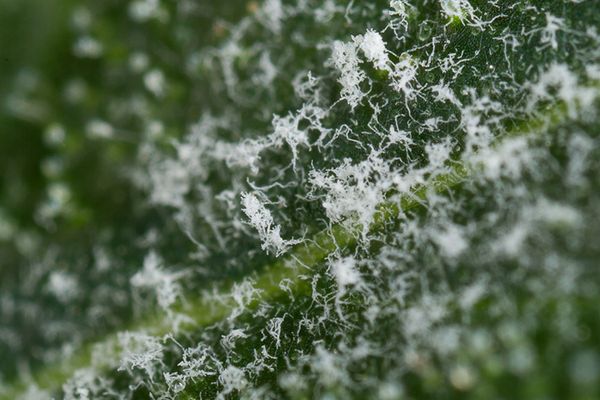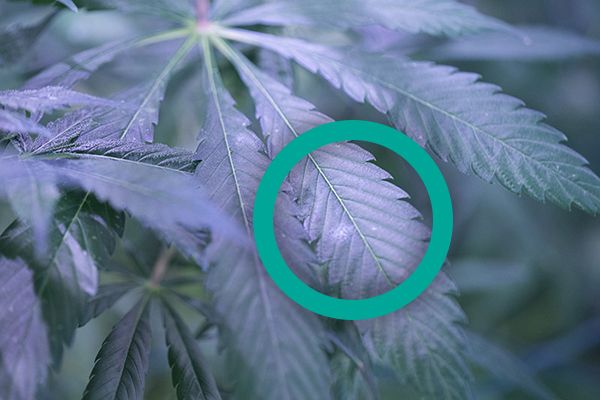- Powdery Mildew is one of the most common fungus in marijuana crops.
- If you are taking your first steps in cannabis cultivation, we recommend that you remain vigilant to stop this uninvited guest from colonising your garden, as if you don’t prevent it or treat it promptly, it can well ruin your whole – yes, your WHOLE – cannabis crop.

What is powdery mildew?
Powdery mildew is the name for the pathogenic fungus that attacks marijuana plants – amongst many other plant species. It can affect both outdoor cannabis crops – particularly in wet months such as September and October – and indoor crops. Once the fungus penetrates the flower, it is no longer fit for consumption as it can cause serious health issues, particularly in the lungs. So much so that the United States Environmental Protection Agency has warned of the damages odium can cause to the respiratory system, particularly in people with lung disease or a weakened immune system.
How to detect powdery mildew?
Powdery mildew goes through different phases and is easy to spot, as it looks like whitish powder. This is the standard process cannabis plants undergo when they become infected with odium:
- The upper side of the leaves develops small, translucent white powder spots (similar to sprinkled flour), normally at the bottom of the plant.
- The white colour of the powder spots becomes more intense and the diameter expands.
- The powder reaches the stems and the buds. Once the spores of the fungus colonise the cannabis flower, it is no longer fit for consumption. At this point you will have to get rid of your crop or at least of part of it.
To treat powdery mildew effectively, it is very important to detect it at an early stage. Being alert when the first symptoms appear can make the difference between effective treatment and a ruined crop. The more time passes from the beginning of the infection, the more the fungus will spread and the more difficult it will be to eradicate.

How to prevent powdery mildew?
If you want to avoid dealing with this fungus, prevention is the best medicine:
If you are growing indoors…
- Try to keep relative humidity at 40%-60%.
- Make sure the ventilation system is working properly. You must pay special attention when the reflectors are off, making sure the extraction rate is the suitable one to keep the plants' transpiration from condensing the air. Another thing to avoid is stagnant air, for which you can use a fan.
- If you have suffered from oidium before, trimming can be a good idea, as too many leaves generate dark areas in the lower part of the plant, which tend to be damp and difficult to ventilate.
If you are growing outdoors…
- Powdery mildew is more common in spring and autumn, so try to be particularly vigilant.
- Get rid of dry leaves, both from the floor and from the stem itself.
- Keep the crop clean.
- Don't place the plants in dark areas.
- Allow space between the plants. Don't place them too close to one another so that the air can circulate. If they are too leafy, trim them out.
How to prevent or treat powdery mildew with organic fungicides?
Of course, prevention is the best way to avoid fungi and to prevent them from ruining your crop. Below you will find a list of organic fungicides you can use for prevention and treatment.
- Horsetail: this plant is used both for preventing and fighting several fungi in marijuana and other vegetable crops. Thanks to its high content in silence and equisetonine – a saponin toxic to fungi – , it is a powerful ally for cannabis growers.
Preparation method: place a horsetail bundle in a pot containing one litre of water and leave it to soak for 12 hours in a fresh area. Heat it over a low heat for 15 minutes and sieve the liquid. Once it cools down and it will be ready to use. Spry the leaves with this preparation – at a rate of one horsetail cup per three water cups – once a week for prevention and every two days for treatment.
- Propolis: an organic fungicide made by bees to protect their hive against bacteria, virus and fungi. You can buy it in online growshops and brick-and-mortar shops and apply it at any moment of the plant's life cycle.
- Trichoderma harzianum: inoculate this antagonistic fungus in the soil to prevent the occurrence of oidium.
- Organic fungicides: there are different products available in the market you can use to treat PM. Oidioprot is a good example.
Here is what to do if powdery mildew occurs during flowering
- Spray with high pH water (8- 8.5) and repeat every 3-4 days.
- Spray with a water and milk solution (90% water and 10% milk).
- You can also spray a solution of water with a dash of hydrogene peroxide.
- Ionizer: installing this appliance for cleaning and purifying the air in your grow room can also be helpful for the prevention and eradication of PM.
Avoid…
- Sulfur: even if spraying the plants with sulfur is a fairly widespread treatment against powdery mildew, we do not recommend it for cannabis cultivation, as the flowers would preserve the flavour and the aroma of this chemical.
- Bicarbonate: spraying your plants with bicarbonate dissolved in water might be effective against powdery mildew, but you should avoid it during flowering if you don't want visible remains to build up.
- Chemical products: even if there are systemic fungicides that can effectively fight powdery mildew, we don't recommend that you use non-organic products, as they can be harmful to health and will end up in your organism when you use the cannabis. If you still want to use them, read the manufacturer's instructions carefully, stick to the recommended dose and thoroughly wash the roots to eliminate as much product as possible from the plant.




Comments from our readers
Read comments in other languages:
Did you like this post?
Your opinion about our seeds is very important to us and can help other users a lot (your email address won't be made public).